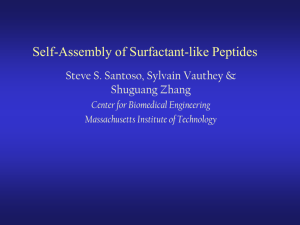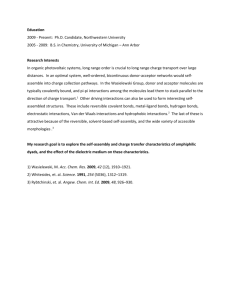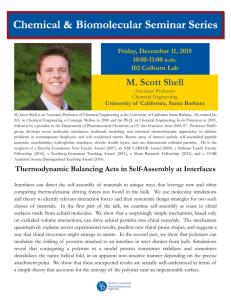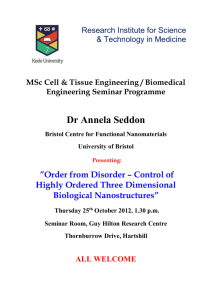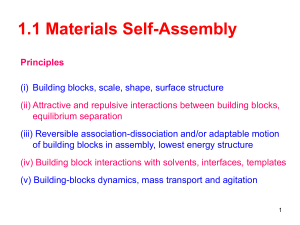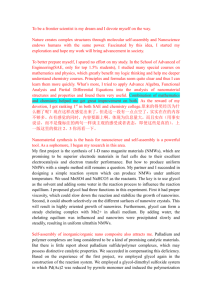Self-Assembly on Various Scales
advertisement
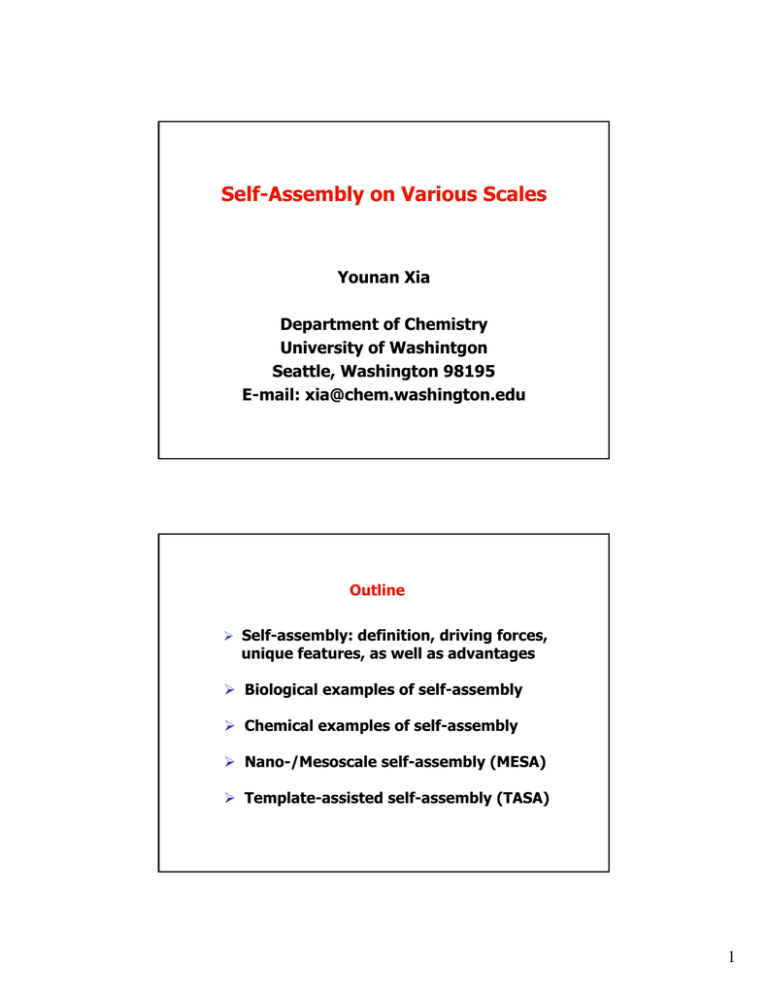
Self-Assembly on Various Scales Younan Xia Department of Chemistry University of Washintgon Seattle, Washington 98195 E-mail: xia@chem.washington.edu Outline ¾ Self-assembly: definition, driving forces, unique features, as well as advantages ¾ Biological examples of self-assembly ¾ Chemical examples of self-assembly ¾ Nano-/Mesoscale self-assembly (MESA) ¾ Template-assisted self-assembly (TASA) 1 Definition of Self-Assembly ¾ Self-Assembly (SA) is the spontaneous organization of molecules or objects into well-defined aggregates via noncovalent interactions (or forces) ¾ Building Blocks: molecules and objects with coded information for self-assembly ¾ Processing: mix, shake, and form product Driving Forces: Attractive vs. Repulsive Atkins & de Paula, Phys. Chem., 7th ed., Freeman, p. 705 (2002) 2 Driving Forces on Various Scales ¾ Molecular Scale: H-bonding, hydrophoic interaction, electrostatic forces, “lock-key” type interactions, and van der Waals forces ¾ Nano- and Mesoscale: capillary forces, external fields (gravitational, centrifugal, magnetic, electric, optical, …… ), surface tension, electrostatic forces, shear forces, and molecule-based interactions Attractive Features of Self-Assembly ¾ Self-assembly proceeds spontaneously ¾ The self-assembled structure is often at or close to thermodynamic equilibrium ¾ Self-assembly tends to reject defects, and also has self-healing capability ¾ The self-assembled structure often has greater order than other systems do (free energy: entropy vs. enthalpy) 3 What Might Self-Assembly Bring to Us? ¾ Simple, parallel, low-cost processing ¾ Small and/or multifuctional structures ¾ Complex structures with fewer defects ¾ Repetitive or reconfigurable structures ¾ Fabrication in inaccessible spaces Lipid Molecules and Cell Membranes Stryer, Biochemistry, 3rd ed., W. H. Freeman, 1988, p.296 4 Tobacco Mosaic Virus (TMV) Stryer, Biochemistry, 3rd ed., W. H. Freeman, 1988, p.852 How Does TMV Self-Assemble? Stryer, Biochemistry, 3rd ed., W. H. Freeman, 1988, p.854 5 Self-Assembly of Surfactant (Soap) Molecules Self-Assembly via Hydrophobic Interaction 6 Self-Assembly via Electrostatic Interactions Dreja, Kim, Yin & Xia, Journal of Materials Chemistry 2000, 10, 603 Self-Assembled Monolayers (SAMs) Bain & Whitesides, Advanced Materials 1989, 4, 506 7 Alkanethiolate SAMs on Gold Surfaces Whitesides & Laibinis, Langmuir 1990, 5, 87 Substrate and Ligand Pairs for Forming SAMs Xia & Whitesides, Angew. Chem. Int. Ed. Engl. 1998, 37, 550 8 Fabrication of Arrayed Magnetic Nanoparticles Zhong, Gates, Xia & Qin, Langmuir, 2000, 16, 10369 Arrayed Co Nanoparticles on SiO2/Si Substrate 75nm x 15 nm 9 Fabrication of Arrayed LEDs by Self-Assembly Whitesides et al, Science, 2002, 296, 323 10 Template-Assisted Self-Assembly (TASA) Yin & Xia, Advaced Materials 2001, 13, 267 Yin, Lu, Gates & Xia, J. Am. Chem. Soc. 2001, 123, 8718 Highlighted as the Editors’ Choice, Science, 2001, 293, 1560 Xia, Yin, Lu & McLellan, Advanced Functional Materials 2003, 13, 907 How Does a TASA Process Work? 11 Attractive vs. Repulsive Interaction pH = 6.5 pH = 8.5 Control over the Self-Assembled Structures 12 Examples of Polygonal and Polyhedral Clusters Templates with Different Cross-Sections 13 Linear and Zigzag Chains of Polystyrene Beads Yin, Lu & Xia, Journal of Materials Chemistry 2001, 13, 1146 Control over the Spatial Orientation of Clusters 14 Hybrid Clusters Consisting of Different Colloids Yin, Lu & Xia, J. Am. Chem. Soc. 2001, 123, 771 Templated Crystallization on Etched Si(100) Wafers 15 Assembly of Spherical Colloids into Spiral Chains Yin & Xia, J. Am. Chem. Soc. 2003, 125, 2048 Control over the Exact Optical Handedness 16 Self-Assembly of 360-nm Silica Beads A B C Fabrication of Arrayed Polymer Microlenses Lu, Yin & Xia, Advanced Materials 2001, 13, 34 17 Imaging through Arrayed Polymer Microlenses Extension to Smaller Scales? ~150 nm PS beads ~40 nm Au beads An Array of ~120 nm Channels by Near-Field Photolithography 18
